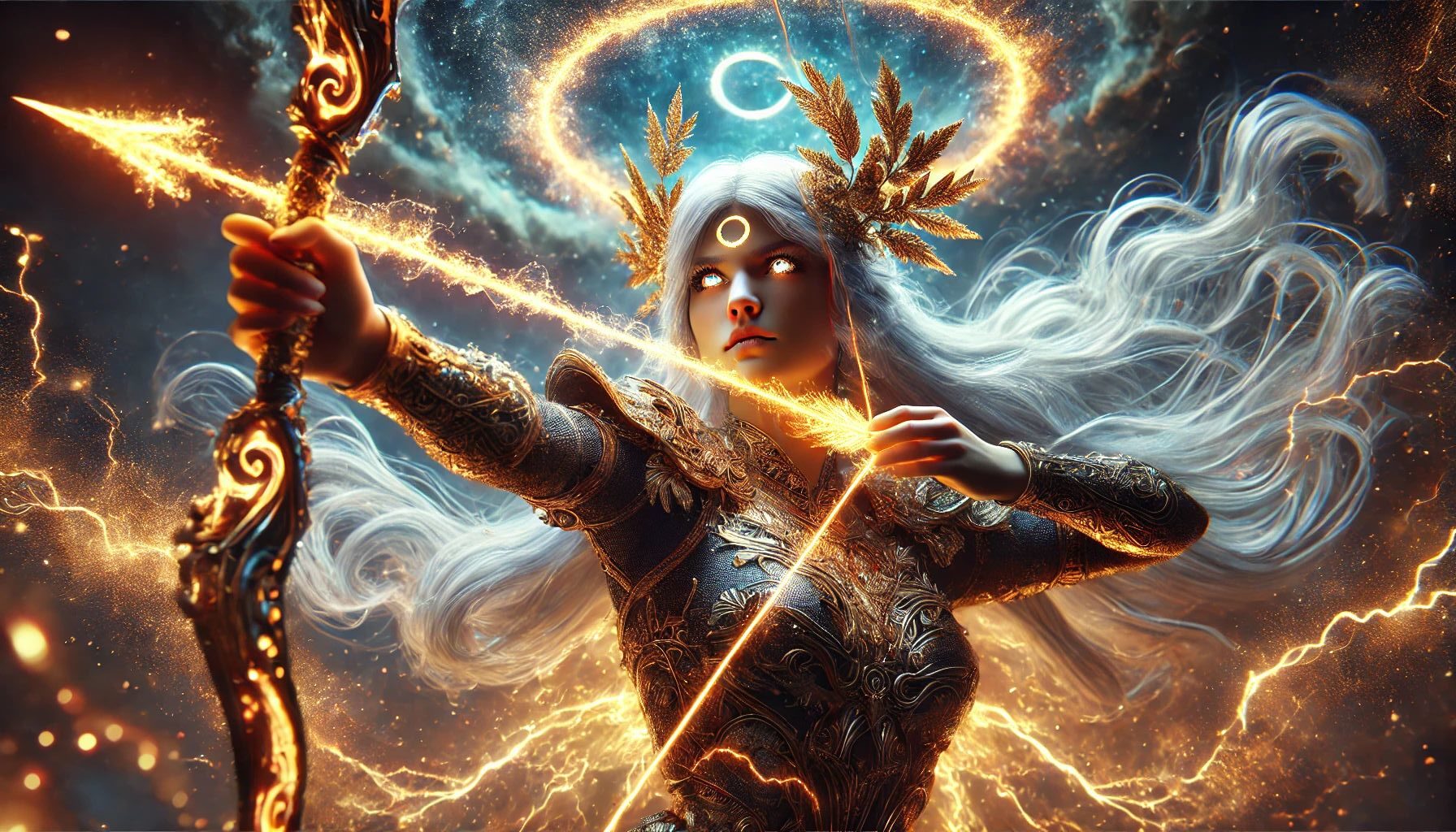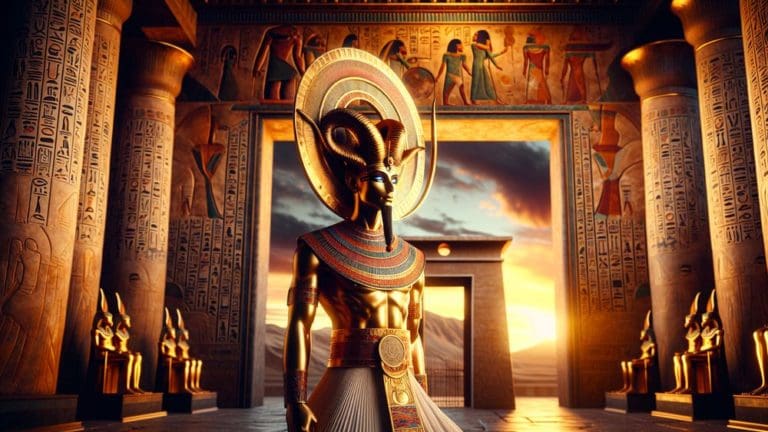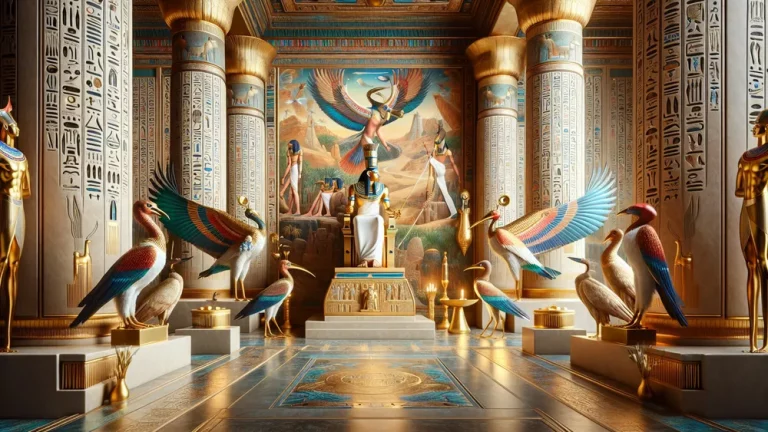Artemis: Greek Goddess Of The Hunt, Moon, And Wilderness
When you consider Greek mythology, the names Zeus, Hera, and Poseidon may come to mind first. But, the group of Greek gods and goddesses is large and complex, where each god or goddess plays a unique role in the ancient world. One figure that interests many people is Artemis, the goddess of the hunt, moon, and wilderness.
Key Points:
- Artemis is a Greek goddess who rules over hunting, the moon, and wild places. She’s the child of Zeus and Leto and twin sister to Apollo.
- Known for her virginity and independence, Artemis isn’t merely a huntress but also a protector of wildlife and young women, making her a symbol of strength and purity.
- Artemis has several symbols tied to her, like the bow and arrow signifying her hunting skills and independence, the moon emphasizing her role as a guide in the night, and the deer and cypress tree symbolizing her connection to nature.
- Important stories about Artemis include the tales of Actaeon, Orion, the Niobids, and the Calydonian Boar Hunt. These myths often teach lessons about respect, consequence, humility, and the dangers of pride.
- Artemis has a distinctive relationship with her twin brother Apollo. Though both gods share interests in archery, music, and healing, they oversee different domains. This balance between them is evident in their shared myths and individual narratives.
- Artemis was highly respected in ancient Greece, with temples built in her honor all over the ancient Greek world. Each temple held a unique cultural significance, with the Temple of Artemis at Ephesus being one of the Seven Wonders of the Ancient World.
- Rituals and festivals like Brauronia and Artemis Orthia were vital parts of Greek culture, honoring Artemis and reflecting societal values. Such rituals often marked transitions in life, like the move from girlhood to womanhood.
Think about someone who represents the spirit of the wild nature, much like a modern conservationist who strongly protects nature and wildlife. Artemis isn’t just a hunter; she is a sign of independence, strength, and purity. When we learn about her story, we discover her origins, her important myths, and the symbols that represent her.
Whether you’re new to Greek mythology or want to deepen your knowledge, this look at Artemis will give you a detailed view of one of the most interesting gods of the ancient world.

Artemis: Overview and Key Facts
| Key Aspect | Information |
|---|---|
| Name | Artemis |
| Role | The goddess who rules the hunt, moon, and wild places |
| Parents | Daughter of Zeus and Leto |
| Siblings | Her twin brother is Apollo |
| Symbols | Bow and Arrow, Moon, Deer, Cypress Tree |
| Traits | Virginity, Independence, Protector of Nature and Young Women |
| Major Myths | Included in her major myths are the birth of Artemis, Actaeon, Orion, the Niobids, and Calydonian Boar Hunt |
| Worship | Temples in Ephesus, Brauron, and Sparta; also, festivals like Brauronia and Artemis Orthia |
| Roman Equivalent | Diana |
| Significance | Represents the wilderness, she is a protector of wildlife, and she is a symbol of chastity and independence |
Getting to Know Artemis
To get a better idea of Artemis’ place in Greek mythology, we will look at her past, her birth, and also her important roles and myths.
Who is Artemis?
Artemis, a well-known god in Greek stories, is the child of Zeus, the top god, and Leto, a Titan woman. She is the twin sister of Apollo, who is the god of the sun and music. Being a goddess who is a virgin, Artemis is often connected with purity and virtue, much like a modern-day sign of being independent and able to look after oneself.

But, her role is more than just a huntress; she is also the goddess of the moon and wild places, representing the wild parts of nature. In ancient Greek culture, Artemis was someone who looked after young women and helped with childbirth, showing her caring and fierce nature.
Her impact was felt in many parts of Greek life, from religious events to daily practices, making her a key figure in the group of Greek gods and goddesses.
Artemis, Zeus’ daughter and Apollo’s twin, is a goddess symbolizing purity and independence, linked to the moon, wilderness, and protecting women, playing a crucial role in ancient Greek beliefs and traditions.
The Birth of Artemis
The birth of Artemis is an interesting story that starts with her parents, Zeus, the king of gods, and Leto, a Titan woman. When Hera, Zeus’ wife, found out Leto was pregnant, she got very jealous and said no land could give Leto a place to have her babies.
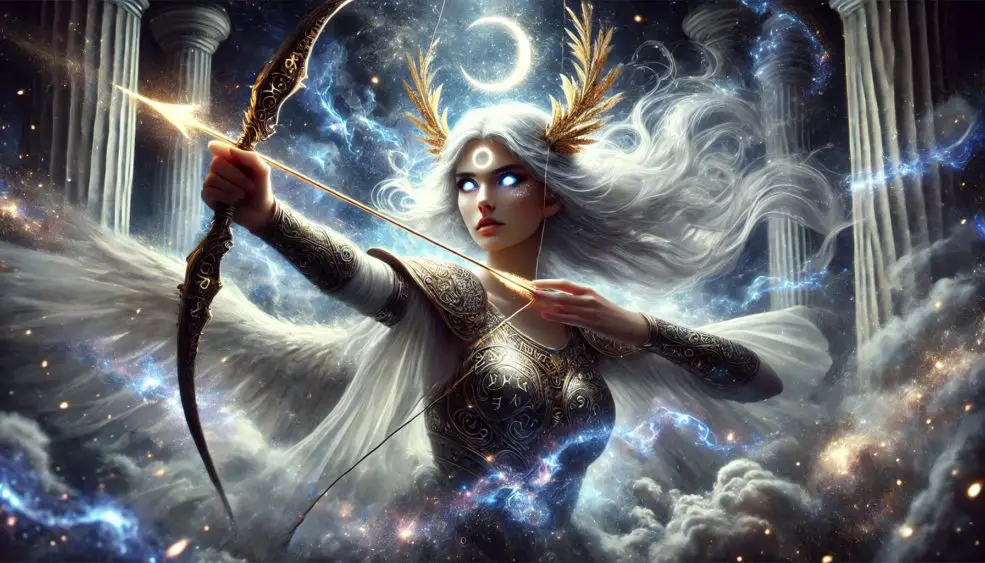
After looking for a long time, Leto finally found safety on the floating island of Delos. This went against Hera’s rule. Next to a palm tree, Leto gave birth to Artemis, who was born first and then helped her mother have her twin brother, Apollo. This story means Artemis is divine and connects her early with childbirth and protection. These ideas would keep describing her in Greek stories.
What Artemis Did in Greek Myths
Artemis had many roles in Greek myths, mainly as the goddess of the hunt, the moon, and the wild. Think of her as guardian of nature, like an environmental protector today, strongly defending the forests and animals. People picture her with a bow and arrow because of hunting. This means she is skilled and independent. As a moon goddess, she appears as a bright figure lighting up the night, helping and protecting travelers.
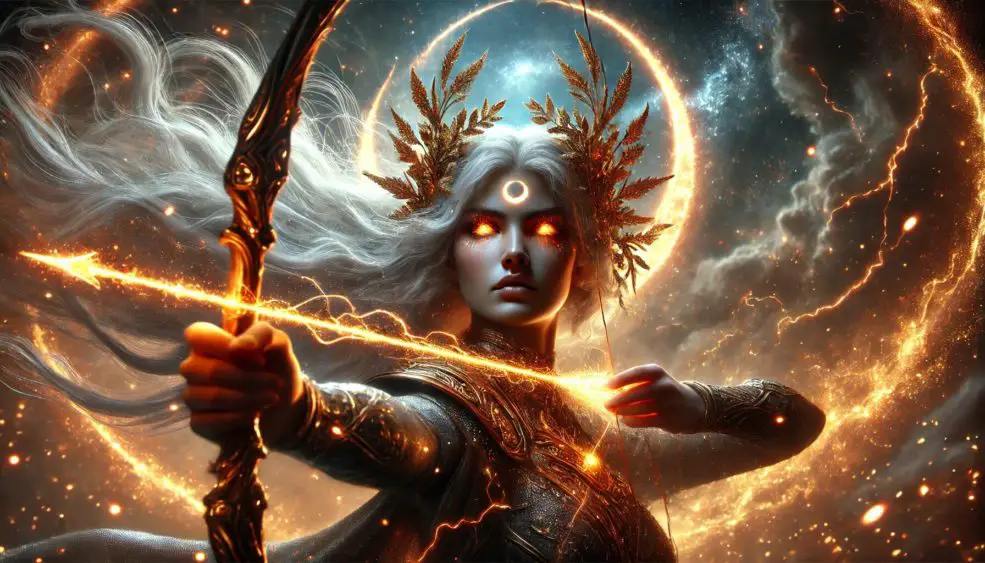
Her promise to stay a virgin, a choice to stay pure, affected how she dealt with humans and gods. This promise is like a strong commitment to an idea, shaping how she acted. For ancient Greeks, Artemis wasn’t just a god to worship. She was a powerful symbol of purity, strength, and untamed natural beauty.
Artemis’ Traits and Symbols
To better understand Artemis’ importance, let’s look closely at the many symbols and traits linked to her.
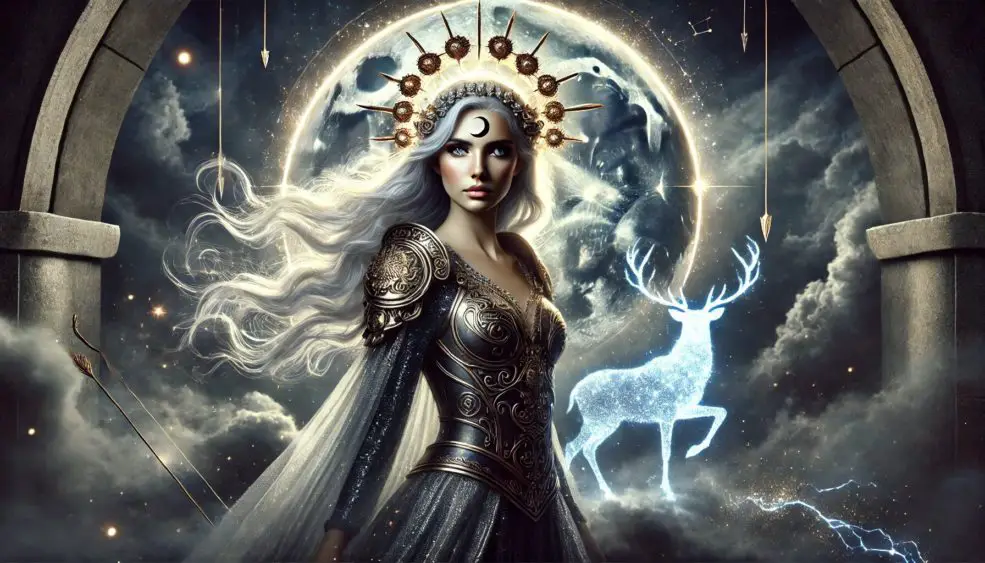
Symbols Linked to Artemis
Several main symbols are connected to Artemis. They underline her different roles and features in Greek myths. These symbols involve:
- Bow and Arrow: Representing her hunter skills, the bow and arrow mean Artemis’ skill, accuracy, and independence, similar to how an athlete’s gear means their skill.
- The Moon: As a moon goddess, the moon means Artemis’ link to the night and her job of guiding and protecting those who travel by its light.
- The Deer: The deer shows Artemis’ strong link to nature and the wild, showing her role as a defender of wildlife and untamed nature.
- The Cypress Tree: This tree is linked with Artemis and means mourning and eternal life, showing her dual role as a nurturer and strong guardian.
Each of these symbols offers a look into the many sides of Artemis, displaying her importance in Greek myths.
The Bow and Arrow
The bow and arrow are main symbols connected to Artemis. They mean her great skill as a huntress. Think of these weapons like an athlete’s equipment today. They don’t just mean skill. They show a strong link to her role. For Artemis, the bow and arrow are more than tools. They mean her strength, accuracy, and independence.
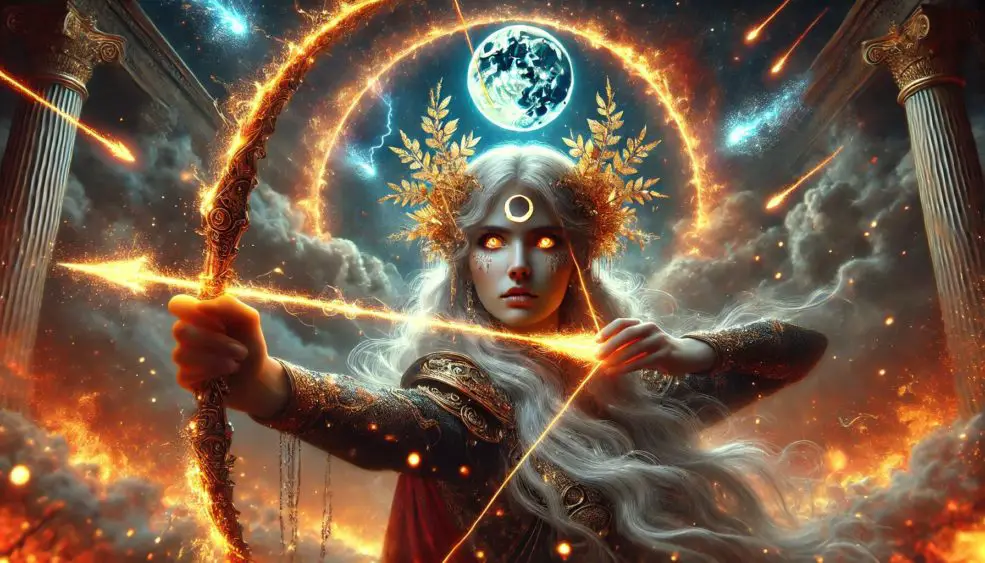
Much like a surgeon’s scalpel means control, Artemis’ bow and arrow mean she can navigate the wild with unmatched skill. These weapons also show her freedom because she moves through forests and mountains without limits. Simply put, the bow and arrow are powerful symbols of her role as a guardian of nature, self-reliance, and mastery.
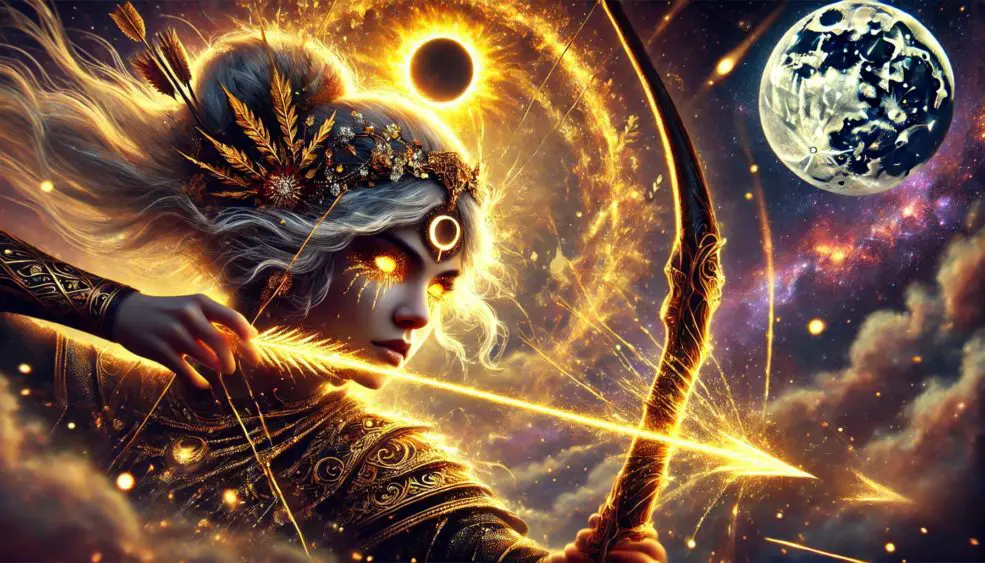
The Moon
Being linked to the moon is an essential part of Artemis’ identity as a moon goddess. Think of her as a constant light in the night. Like the moon, which means light and safety in darkness, Artemis provides these too. This role also means she affects the natural cycles of the world, similar to how the moon affects the tides.
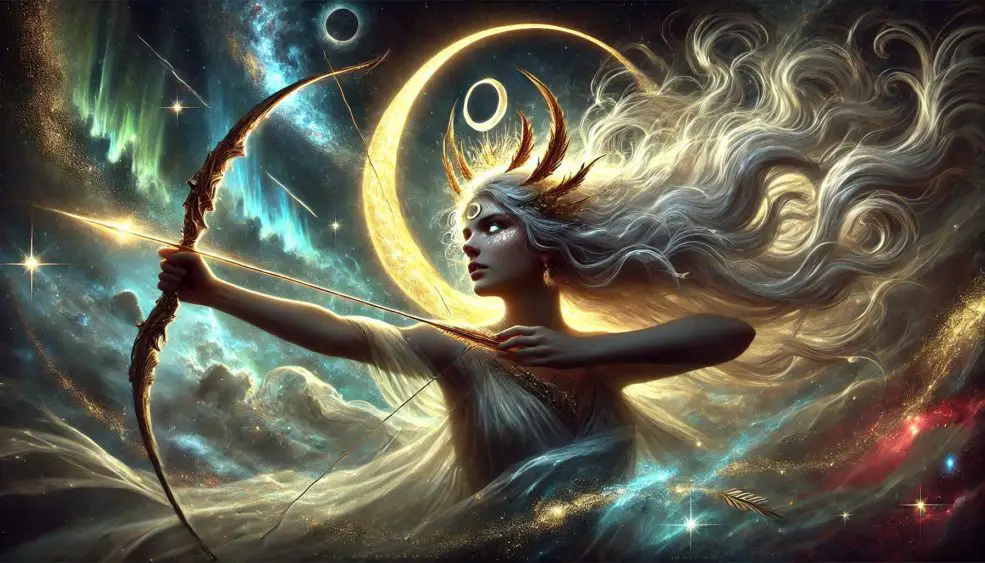
Myths often describe Artemis as a bright figure, lighting up the night and giving comfort to those wandering under her gaze. Her moon part makes her both nurturing and powerful, showing the calm and strong sides of the night. This mix makes Artemis a respected figure, being both a protector and a huntress.
Artemis’ connection to the moon is crucial to her identity, making her a guiding light in the dark night, offering comfort and safety like the moon does, influencing nature’s rhythms and described as a radiant presence that brings solace and protection, blending nurturing and formidable traits, earning her admiration as a guardian and a hunter.
The Deer
The deer is important in Artemis’ myths, meaning her deep connection to nature and the wild. See the deer as a real example of the untamed beauty and grace in the natural world, like a butterfly means change and delicacy. Depictions in many myths often place Artemis beside deer. This underlines what she does as a protector of wildlife and the forests.
The deer, with its quick and agile moves, is like Artemis. She moves through the wild with skill and accuracy. It also means the purity and innocence that Artemis has. She is seen as a guardian of young animals and a caretaker of nature. Through the deer, we see Artemis’ bond with the wild.
It shows her as both a strong, fierce huntress and a gentle protector of all living things.
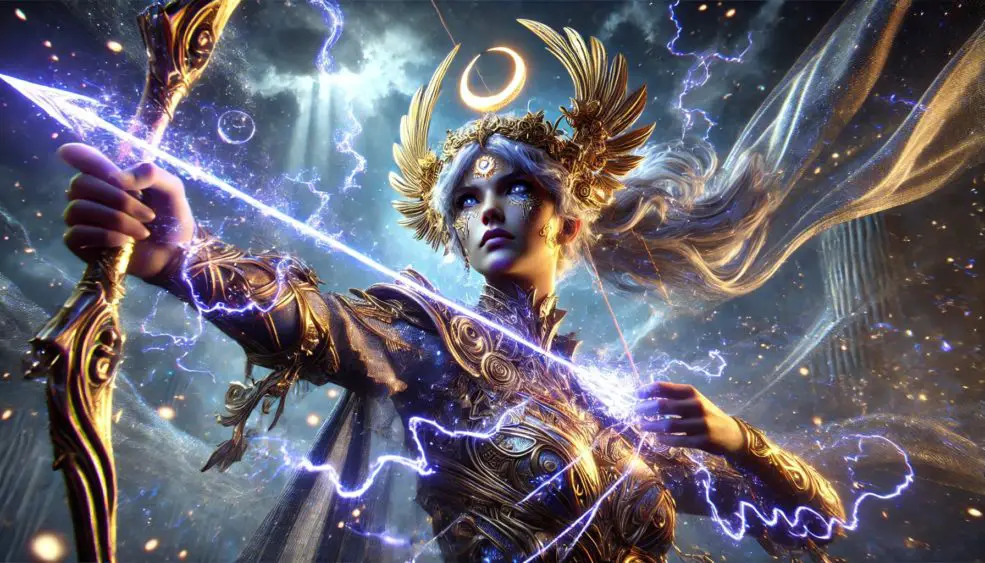
Stories About Artemis
After we looked at the symbols and features of Artemis, we can jump into some of the most interesting myths about this goddess.
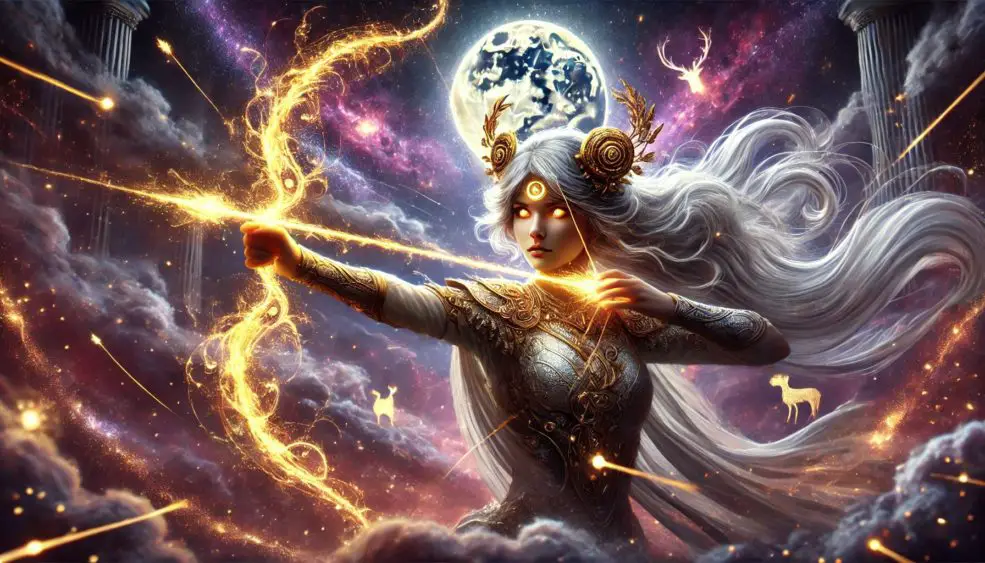
The Myth of Actaeon
The story of Actaeon is a touching tale that highlights themes of respect and consequence in Greek mythology. Actaeon was a skilled hunter who unknowingly walked in on Artemis while she was bathing in a hidden forest pool. Think of this like someone today accidentally intruding on a private moment, leading to severe consequences. Angry about this, Artemis turned Actaeon into a stag.
This change was not just to punish him but also a strong symbol of his new weakness. As a stag, Actaeon was no longer a hunter but the hunted. Unable to recognize him, his own dogs chased and killed him. This sad ending means a strong reminder of respecting divine boundaries and the serious outcomes of unintended transgressions.
The Tale of Orion
The story of Orion is a complex myth that looks at themes of friendship and jealousy and tragedy. Orion, a giant hunter, bonded closely with Artemis, sharing a strong passion for hunting. This was a deep friendship. However, the story has many versions, each with different endings for Orion.
In one version, Apollo, Artemis’ brother, got jealous of their friendship and tricked her into hitting Orion, who was swimming far out at sea, by daring her to hit a far-off target. Without knowing, Artemis shot Orion, causing his death.
In another version, Orion bragged about his hunting skills, saying he could kill all the animals on Earth, angering Gaia, the Earth goddess, who sent a giant scorpion to kill him. No matter the version, Orion’s death is a clear reminder of the fragile nature of life and the consequences of actions driven by jealousy or hubris.

Artemis and the Niobids
The story of Niobe is a powerful lesson in humility and the dangers of pride. Niobe, who was a queen in Thebes, bragged she was better than Leto, the mother of Artemis and Apollo, because she had fourteen children while Leto had only two.
Think of this like someone today bragging too much about their successes, only to face serious consequences later. Enraged by Niobe’s arrogance and disrespect towards their mother, Artemis and Apollo chose to get back at Niobe for Leto. Apollo aimed at and killed Niobe’s sons, while Artemis, with her perfect aim, struck down Niobe’s daughters. This tragic event left Niobe devastated; she turned to stone, forever crying for her lost children.
The myth emphasizes the need for humility and respect, showing how the gods quickly punished those who dared to challenge their honor and that of their loved ones.

Niobe’s story warns against pride and the importance of humility through her tragic fate after boasting about her children, teaching a lesson about the swift consequences of disrespect towards the gods and their family.
The Calydonian Boar Hunt
The Calydonian Boar Hunt is an exciting story that shows Artemis’ influence and the bravery of ancient heroes. King Oeneus of Calydon forgot to honor Artemis in his yearly sacrifices, so the goddess sent a huge boar to destroy the land. Think of this like a situation today where a big mistake leads to a major problem.
To fight the beast, a group of famous heroes, including Atalanta, Meleager, and Theseus, came together. Faced with the beast, Atalanta, a fierce huntress liked by Artemis, was the first to injure the boar, showing her amazing skills and Artemis’s favor. Meleager gave the final blow, but the fight over the prize led to more tragedy afterward.
This story means the importance of respecting the gods and the collaborative efforts needed to beat tough challenges, showing also the potential for arguments even among friends.
Artemis’ Connections with Other Gods and Mortals
Through her dealing with other gods and people, we learn a lot about her character and influence in Greek myths. Let’s learn more about these connections in detail.
Artemis and Apollo
Artemis and Apollo are twins of Zeus and Leto, with a connection that is both working together and unique, much like modern siblings who share interests but have different personalities. Both gods are tied to archery, music, and healing, yet they oversee different areas – Artemis with the wild and hunting, Apollo with the sun, music, and future predictions.
Working together, they avenged their mother Leto by killing the Niobids, revealing their loyalty and combined strength. While they share these traits, there are clear differences: Artemis is a virgin goddess who values independence, and Apollo is often seen as a light god involved in many love stories. This balance shows how they complement each other, mixing the wild with the orderly, the moon with the sun, in Greek stories.
Worshipping Artemis
Knowing how Artemis connects with other gods helps us see why she was so respected in ancient Greece. Now, let’s talk about how people in Greece respected her.
Temples for Artemis
Temples built for Artemis were not only places to pray, but also cultural landmarks that had great historical importance. These temples could be found all over the ancient Greek world, and each one had its own special role. For example, the Temple of Artemis at Ephesus, one of the Seven Wonders of the Ancient World, was a huge building that people from many places visited. The Brauron sanctuary in Attica was another key site where young girls went through rites of passage. Below is a table listing some of the most important temples built for Artemis:

| Temple Name | Location | Historical Importance |
|---|---|---|
| Temple of Artemis at Ephesus | Ephesus, Turkey | One of the Seven Wonders of the Ancient World, known for its size and beautiful design. |
| Brauron Sanctuary | Attica, Greece | A major place for worshipping Artemis, especially known for rites with young girls. |
| Temple of Artemis Orthia | Sparta, Greece | Famous for its unique ceremonies and the worship of Artemis Orthia, a local version. |
| Temple of Artemis at Sardis | Sardis, Turkey | An important religious place in the old city of Sardis, showing how widespread the worship of Artemis was. |
Rituals and Celebrations
Rituals and festivals to celebrate Artemis were important to Greek culture, much like how today’s festivals celebrate key events. Among the many festivals, the Brauronia festival at Brauron in Attica stood out. Young girls called “arktoi” or “little bears” took part in rites that included dancing and giving offerings to Artemis. This meant moving from girlhood to womanhood. Another well-known celebration was the Artemis Orthia in Sparta.
It involved hard and sometimes painful rites, showing the Spartan focus on endurance. These festivals not only honored Artemis, but also reflected social and cultural values, making them essential to old Greek times.
Greek culture valued rituals and festivals dedicated to Artemis, like modern celebrations marking key events, with noteworthy festivals including the Brauronia festival in Attica and the Artemis Orthia in Sparta, both symbolizing transitions from girlhood to womanhood and emphasizing endurance in Spartan culture.
Pantheon of All the Greek Mythology Gods
To really get Artemis’ place in Greek mythology, it’s important to look at the larger group of gods and goddesses she’s a part of. Greek mythology is like a big family with each god or goddess having their stories and attributes. For a complete overview, you can see this list of all Greek Gods.
This gives detailed info on each god, and it helps to know where Artemis fits among her divine peers.
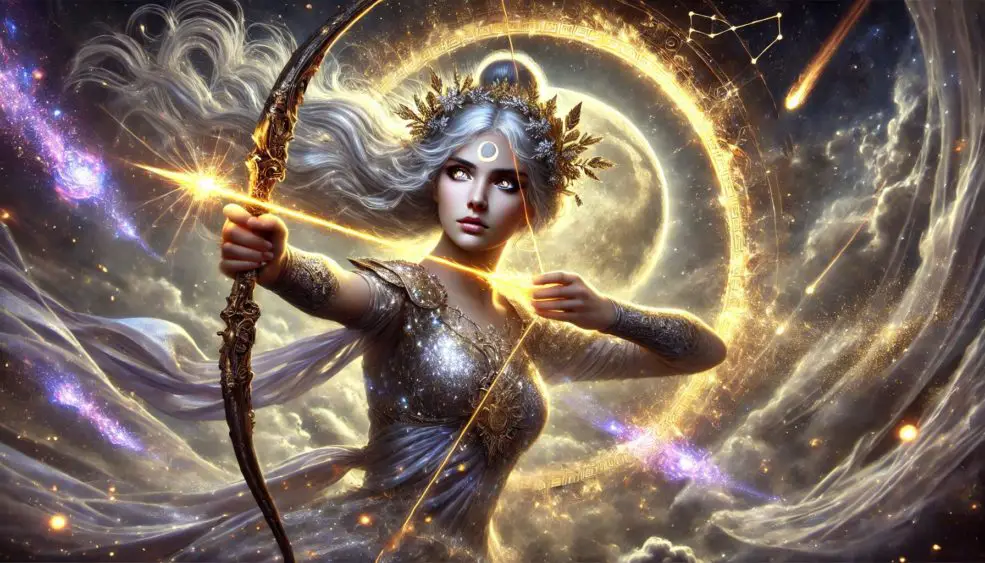
FAQs
1. What are Artemis’ main symbols?
Artemis’ main symbols include the bow and arrow, the moon, and the deer, each representing different aspects of her divine attributes.
2. How is Artemis related to Apollo?
Artemis is related to Apollo as his twin sister, both being the children of Zeus and Leto.
3. What are some famous myths involving Artemis?
Some famous myths involving Artemis include the tales of Actaeon, Orion, and the Calydonian Boar Hunt.
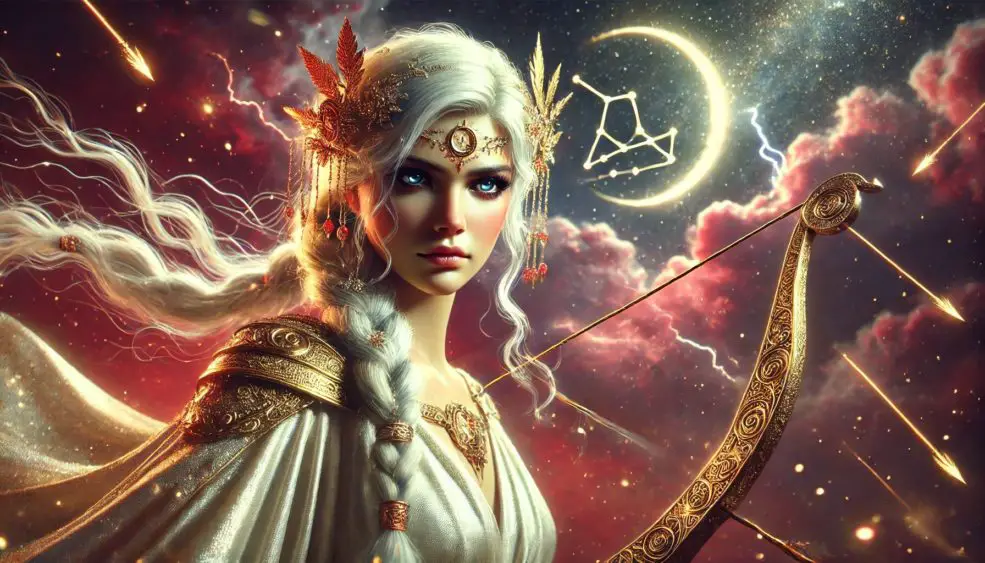
4. How was Artemis worshipped in ancient Greece?
How Artemis was worshipped in ancient Greece involved various rituals, festivals, and the dedication of temples in her honor.

